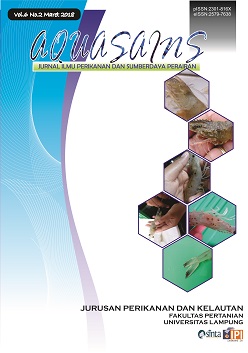MEDIA POROSITY in SILK WORM CULTURE (Tubifex sp.)
DOI:
https://doi.org/10.23960/aqs.v6i2.p611-614 Abstract View: 798
Abstract View: 798
Abstract
The content of organic matter can affect the growth of silk worms (Tubifex sp.). In addition, media porosity can also have an effect. This study aims to determine the effect of porosity on the cultivation of silk worm by using media of mud and sandy mud. The analysis used a complete randomized design method with three replications. The silk worm population in mud and sandy mud is 521 and 984, with ABW (Average Body Weight) growth of 0.3 mg and 0.1 mg. These results prove that porosity affects the population, whereas organic matter affects the weight of silk worms. So it can be concluded that the use of sandy mud media produces a higher population, but has lower ABW than the mud media.

.png)










